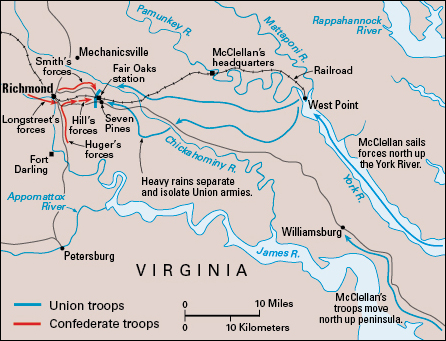Fair Oaks, Battle of, was an important battle of the American Civil War (1861-1865). The battle took place in eastern Virginia on May 31 and June 1, 1862. Confederate forces led by General Joseph Johnston attacked a Union force led by General George McClellan. However, the Confederate leaders mismanaged the attack, and Union soldiers forced the Confederates to retreat. During the battle, Johnston was wounded and eventually replaced by General Robert E. Lee.

The Battle of Fair Oaks is named for a railroad station on the battlefield. The conflict is also called the Battle of Seven Pines, after a village east of the Fair Oaks station.
Background.
In the spring of 1862, General McClellan sailed his Union army from Washington, D.C., to the peninsula between the York and James rivers in Virginia. The move marked the beginning of the Civil War’s peninsular campaign. McClellan’s forces, which would grow to about 105,000 soldiers, moved toward the Confederate capital at Richmond, Virginia. About 60,000 Confederate troops opposed McClellan’s advance.
McClellan’s troops camped about 6 miles (10 kilometers) east of Richmond. McClellan expected reinforcements, led by General Irvin McDowell, to join the Union assault on the city. McDowell marched his men south toward McClellan. McClellan sent more than half of his army north of the Chickahominy River to prepare for McDowell’s arrival. The rest of McClellan’s army remained south of the river. However, Confederate General Stonewall Jackson’s Shenandoah Valley campaign prevented McDowell from joining forces with McClellan.
Heavy rains swelled the Chickahominy River. Many bridges became unusable, and the two Union armies were essentially isolated from each other. Johnston decided to focus his attack on the Union troops south of the Chickahominy. He left behind some troops to contain the Union soldiers to the north.
The battle.
On May 31, Johnston divided his Confederate force into three wings. The wings were headed by generals James Longstreet, D. H. Hill, and Benjamin Huger. Longstreet’s wing was reinforced by troops under General William Whiting. Johnston ordered his generals to march on three different roads that met where the Union troops were positioned.
Johnston hoped to defeat the Union soldiers south of the river before troops north of the river could arrive to help. However, Longstreet marched his men on the wrong roads, and his troops became entangled with the other Confederates. The confusion held up Huger’s and Hill’s forces and delayed the attack.
Around 1 p.m., Hill grew impatient and attacked the Union force. He did so without waiting for Longstreet and Huger to get into position. Hill’s attack pushed back the Union troops, but the retreating soldiers formed another line. They eventually halted Hill’s attack. Whiting tried to assist Hill, but he was stopped by Union troops from the north who had managed to cross the river. The fighting ended when night fell.
That evening, while inspecting the Confederate lines, Johnston was severely wounded by the Union army. General Gustavus Smith replaced him. On the morning of June 1, the Confederates renewed their attack. However, Union reinforcements crossed the river and helped halt the Confederate assault. Confederate President Jefferson Davis replaced Smith with General Robert E. Lee. Lee withdrew his troops back toward Richmond.
The aftermath.
Over the course of the Battle of Fair Oaks, the Union suffered 5,031 casualties (soldiers killed, wounded, or captured). The Confederates suffered 6,134. About a month later, Lee and McClellan fought in the Battles of the Seven Days, in southeastern Virginia. Lee stopped McClellan’s drive to Richmond and forced the Union troops to withdraw from the peninsula.
